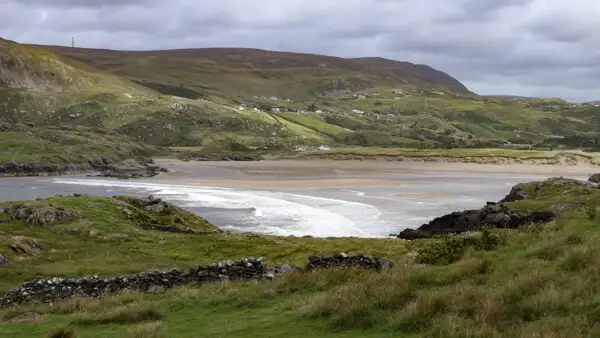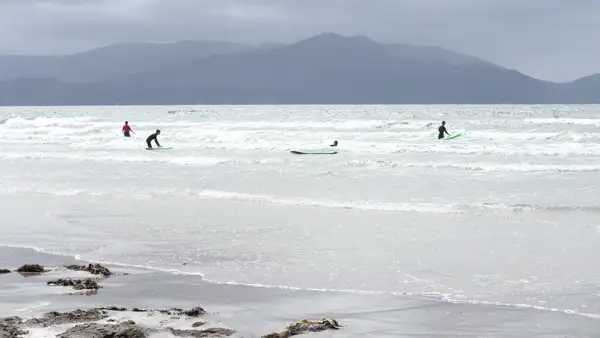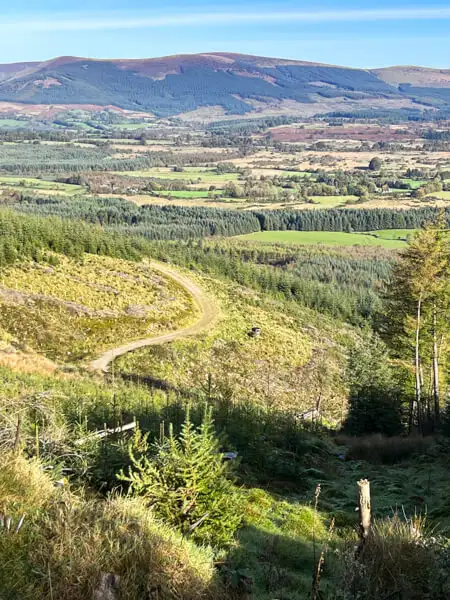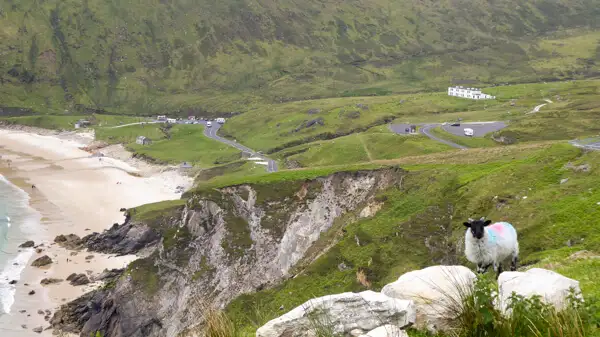Many people who visit Ireland consider camping there. Especially for hikers this seems to be a good idea – doesn’t it?
In the following article, we will explore this question and answer some of the most frequently asked questions about camping and wild camping in Ireland:
Page Contents (click line to jump the text)

Should I bring my tent to Ireland?
If you have camped in Northern European countries before and would like to answer this question with yes, you can skip this part.
All others may pause for a moment and consider whether they would like to pitch their tent after a long, possibly wet day of hiking and put on their possibly clammy clothes again the next morning?
Or whether a hostel or B&B might be warmer and drier? Yes, it’s more expensive, but a dry bed, a warm shower and breakfast in the morning are already pleasant…
The answer to this question is of course up to you, your travel budget and/or your need for comfort – just let the thought “sink in”….
But if you are interested in camping while hiking, I have summarised some helpful information for you below.
By the way, we live in Ireland (second home) and I have done a lot of hiking in Wicklow Mountains and other places.
But back to the topic:
Am I allowed to go wild camping in Ireland?
The short answer to this question is: NO. Wild camping is not allowed in Ireland.
Fortunately, the Irish think less black and white than we Germans do. And so there are places where camping is exceptionally allowed and places where it is usually tolerated if the campers abide by certain rules.
So what now?
In Ireland, almost all land is privately owned. Almost, because most of the larger forest areas are managed by Coillte, a state forestry company. Many of the long-distance footpaths in Ireland pass through Coillte land via forest tracks. Some of these long-distance trails have been equipped with open shelters. You are also allowed to stay overnight or pitch your tent there.
Three such huts or shelters can be found on the Wicklow Way, but there are also permitted overnight spots on the Slieve Bloom Way, the Kerry Way, the Avondhu Way, or the Western Way. A lot is happening here at the moment, and more tent possibilities could be added in the near future.
There are already some official campsites on Coillte land, for example in Lough Key Forrest Park and Curragh Chase Forrest Park.
Practically all waterways, such as the Royal Canal Way, the Grand Canal Way or the Barrow Way have locks and other fortified facilities. I have not found anywhere that camping is allowed there, but it is done by walkers, water sports enthusiasts and cyclists everywhere and is quite obviously tolerated.

There are usually no-tenting signs at the beach car parks, but if you are at a small beach in the middle of nowhere (not the big tourist beach), a small tent at the edge of the car park is usually “overlooked”.
Private land also offers opportunities: ask the farmer if you can pitch your tent on one of his meadows and often you can. Maybe it costs a few euros on the hand, but that’s all right in the interest of both sides. In return, you might also be allowed to fill up your water bottle at the tap or use the toilet.
The big long-distance hiking trails often have stops in villages or small towns, where there is also a campsite.
If you are somewhere on the mountain and have no one to ask, it is usually tolerated to spend a night in a tent on the side of the trail.
In some national parks, camping is even officially allowed. For example, in Ballycroy National Park, Connemara National Park and Wicklow National Park, with the exception of Glendalough. However, open fires are usually prohibited in National Parks.
Where are the campsites and how do I find them?
You can find campsites that have been inspected by the Tourist Board on www.campingireland.ie. You can find more addresses in Google Search, Google Maps, on www.booking.com, or on www.camping.info. There are also many small private campsites that you can only find locally – just ask on the way.
What is Leave-no-Trace-Ireland?
Leave-no-Trace is an international organisation that aims to contribute to ecologically sound and sustainable outdoor tourism through education, training and codes of conduct. There is also an Irish branch of the organisation.
Basically, it’s about you behaving prudently and considerately in nature, thereby giving yourself and everyone after you an enjoyable experience of nature.
The main rules of Leave-no-Trace are:
+ Plan ahead and be well prepared
+ Be considerate of others
+ Show consideration for farm animals and wildlife
+ Walk and camp on solid ground (stay on the trails)
+ Leave everything as you found it
+ Take away everything you bring (do not leave rubbish behind)
+ Be very responsible with fire

What about making a fire or cooking while camping in Ireland?
Open fires are prohibited in most national parks. Wherever it is not explicitly allowed, i.e. fireplaces are provided, it leads to suspicion.
You can see the smoke for miles and farmers are quick to worry if the smoke is coming from their sheep pasture…this is also true on the high moors of the mountains where sheep also graze.
I would completely advise against open fires out in nature, it only causes trouble. A smoke-free small petrol or gas cooker is usually no problem.
At campsites there are often fireplaces where you can light a fire.
Long-distance hiking trails – where can I find food and drink?
Most long-distance trails pass through villages and small towns at very regular intervals, where there is almost always a small grocery shop or supermarket where you can replenish your supplies.
However, there are also hiking trails in very rural areas where the trip to the next town means a diversion of several or quite a few kilometres, or where there is simply no useful infrastructure for a day or two.
Therefore, you should always have enough supplies with you and plan your stages well in advance. Emergency rations of concentrated trekking food, which you can easily get in good outdoor shops, are helpful. These meals are often not cheap, but they are nutritious and easy to carry.
You should also carry plenty of water, as the streams and rivers on your way often feed from the high moors – and do not always have clear water. Even if the quality is safe, you may not want to drink the reddish or brownish coloured water. Besides the water bottle, a small water bag (3-5 litres) can be a good addition to your equipment.
Important equipment tips for camping in Ireland
It can get wet in Ireland. It doesn’t have to, but it can. And it can also get very wet if you’re unlucky. And when it gets wet, it often gets windy too, and the two together can mean it gets chilly.
In summer you can have 25 degrees (Celsius) during the day and only 12 degrees at night. In spring or autumn it might be 15 degrees during the day but only 6-8 degrees at night. On the mountains or in places exposed to the wind, it can be a few degrees less.
This means you should prepare your equipment for wet and cool weather – and be happy when it stays warm and dry.
Your tent should be big enough to hold all your gear as well as yourself. Some take the small awning for this, I would even take the things inside the tent. Also the boots.
Then it makes sense to take a waterproof tarpaulin with you, which you can put under the tent. This protects the floor of the tent and helps to keep the tent dry inside.
Most tents have an inner tent and an outer tent. The latter gets wet when it rains. You can consider packing the inner and outer tents in separate waterproof bags so that they don’t all get wet when you pack them.
The outer tent should be waterproofed before the trip, as should your rainwear and boots.
A good base layer is important to avoid getting cold. Mats are not bad, but an inflatable solution might be better. It also helps to prevent stones and the like from pressing into your back.

The sleeping bag should be well warm. Most sleeping bags have two temperature ranges, an extreme range and a comfort range. We are talking about holidays here, not survival, so let’s forget about the extreme range.
The comfort range is usually a bit optimistic (tested under ideal conditions). So you shouldn’t choose too tight, especially if you are exhausted after a long day of hiking, you shouldn’t have to freeze. So feel free to choose a sleeping bag that is rated for much colder temperatures than you expect – it’s not a mistake.
Always keep your sleeping bag dry – a waterproof pack bag is an important helper!
Instead of pyjamas, you can pack a set of long functional underwear – it’s light, warm and you can wear it under your hiking clothes on cool days. And if it does get too warm? Then sleep in a T-shirt.
Think about whether you want to carry a cooker. On the one hand, a warm cup of tea or soup is a blessing, but on the other hand you have to bring it, the food and the water with you (the water in the mountains usually comes from the high moors – I wouldn’t want to drink that). Maybe a sandwich and your water is enough for the overnight stay and in the morning you descend to the next village and find a warm Irish breakfast and a coffee?
Conclusion
So, I think you’re well covered with information about camping on your trek. As you can see, there are many options for you to pitch your tent along the way.
If you are in the grey area where camping may not be explicitly allowed but is apparently tolerated and you can’t ask a landowner for permission, remember the Leave-no-Trace rules. The more prudent we all behave in nature, the longer our outdoor experience will be allowed, or at least tolerated.
With this in mind, have fun hiking and camping in Ireland!
More interesting articles for you
HILLWALKING IN IRELAND – THE MOST BEAUTIFUL CLIMBS FOR BEGINNERS
THE MOST BEAUTIFUL HIKES IN THE SOUTHWEST OF IRELAND
THE ULTIMATE PACKING LIST FOR MULTI-DAY HIKES IN IRELAND
Photo credits cover photo: Sheep at Mount Leinster, photo by Ulrich Knüppel-Gertberg (www.irland-insider.de, www.ireland-insider.com)